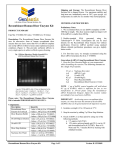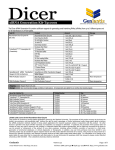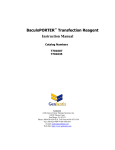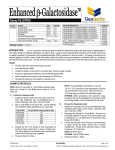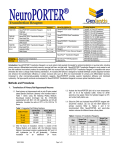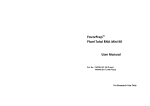Download TurboScript™ T7 Transcription Kit
Transcript
IMPORTANT: All reagents should be microfuged briefly before opening to prevent loss and contamination of material that may be present around the rim of the tube. A division of Gene Therapy Systems, Inc. 1.2. Assemble the transcription reaction at room temp. The following amounts are for a single 20 µl reaction. Reactions may be scaled up or down if desired. TurboScript™ T7 Transcription Kit PRODUCT SUMMARY Cat. No: T510003 Description: The TurboScript™ T7 Transcription Kit utilizes a novel technology to allow rapid synthesis of 10 to 50 times the amount of RNA produced by conventional in vitro transcription reactions. The secret behind the high yield is that each DNA template is copied hundreds of times. The TurboScript™ T7 Transcription Kit is ideal for preparing double-stranded RNA for use with the Dicer siRNA Construction Kit. Each TurboScript™ T7 Transcription Kit provides sufficient reagents for performing 20 transcription reactions. Please note: The TurboScript™ T7 Transcription Kit is intended FOR RESEARCH USE ONLY Components: Description T7 Enzyme Mix T7 Reaction Buffer NTP Mix DNase I 2X Gel Loading Buffer Nuclease-free Water LiCl Precipitation Solution GFP Control Plasmid 5’ Control Primer 3’ Control Primer Add to 20 µl 8 µl 2 µl 1 µg 2 µl Nuclease-free Water NTP mix T7 Reaction Buffer DNA template T7 Enzyme Mix IMPORTANT: The spermidine in the T7 Reaction Buffer can co-precipitate the template DNA if the reaction is assembled on ice. Add the T7 Reaction Buffer after the water and the NTP Mix are already in the tube. 1.3. Gently flick the tube or pipette the mixture up and down gently then microfuge the tube briefly so that the reaction mixture is at the bottom of the tube. 1.4. Incubate at 37°C for 2-4 hours. Quantity 1 tube (40 µl) 1 tube (40 µl) 1 tube (160 µl) 1 tube (20 µl) 1 tube (700 µl) 1 tube (1ml) 1 tube (700 µl) 1 tube (10 µl @ 1µg/µl) 1 tube (40 µl @ 1 µg/µl) 1 tube (40 µl @ 1 µg/µl) Shipping and Storage: The TurboScript™ T7 Transcription Kit is shipped frozen. For maximum stability and long-term use, immediately store at –20oC upon receipt. All components are stable for six months when stored properly. TIP The first time a new template is transcribed, the recommended incubation time is 2–4 hours. To determine the optimum incubation time for maximum yield with a given template, a time-course experiment can be done. To do this, set up a TurboScript™ T7 Transcription reaction, and remove aliquots of the reaction at various intervals (for example after 1 hour, 2 hours, 4 hours, 6 hours, and overnight incubations). 1.5. Add 1 µl DNase I to each 20 µl T7 Reaction. Mix well and incubate for 15 min at 37°C. NOTE: The DNase I treatment removes the template DNA. 1.6. Check the RNA on a 1% agarose gel (TAE) by using the 2X Gel Loading Buffer. NOTE: dsRNA will migrate like DNA i.e. a 500 bp dsRNA will migrate at the same rate as a 500 bp band in a DNA ladder. ssRNA will migrate much faster than a dsDNA of the equivalent size. You may see faint slower-migrating bands above the full-length transcript on non-denaturing gels. These may be the result of secondary structures within the transcript and should be ignored. METHODS AND PROCEDURES 2. Recovery of dsRNA 1. Generation of RNA 1.1. Thaw the frozen reagents. Place the T7 Enzyme Mix on ice; it is formulated in glycerol and does not freeze at -20°C. Vortex the T7 Reaction Buffer and the NTP Mix until they are completely in solution. Once thawed, store the NTP Mix on ice, and keep the T7 Reaction Buffer at room temperature while assembling the reaction. TurboScriptTM T7 RNA Transcription Kit Page 1 of 1 Double-stranded RNA can be directly use for the Recombinant Dicer Enzyme Kit without purification. However, dsRNA purified using the following procedure can give slightly better results. Version MV032206 2.1. Precipitate the RNA by adding 30 µl Nuclease-free Water and 30 µl LiCl Precipitation Solution to the mixture from Step 1.5. 2.2. Mix thoroughly. Chill for > 30 min at –20°C. 2.3. Centrifuge at 4°C for 15 minutes at maximum speed to pellet the RNA. 2.4. Carefully remove the supernatant. Wash the pellet once with ~1 ml 70% ethanol and centrifuge again to maximize removal of unincorporated nucleotides. 2.5. Carefully remove the 70% ethanol, and resuspend the RNA in Nuclease-free Water or TE Buffer. Determine the RNA concentration and store at –20°C or –70°C. IMPORTANT Lithium chloride precipitation may not efficiently precipitate RNAs smaller than 300 nucleotides. Also, the concentration of RNA should be at least 0.1 µg/µl to assure efficient precipitation. To precipitate from TurboScript™ reactions that are thought to have very low yields of RNA, do not dilute the transcription reaction with water prior to adding the LiCl Precipitation Solution. 3. Quantitation of dsRNA 3.1. Quantitation by UV light absorbance Reading the A260 of a diluted aliquot of the reaction is clearly the simplest way to determine yield, but any unincorporated nucleotides and/or template DNA in the mixture will contribute to the reading. We recommend to do a 1:500 dilution of one aliquot of a TurboScript™ reaction. For single-stranded RNA, 1 A260 unit corresponds to 40 µg/ml, so the RNA yield can be calculated as follows: A260 X dilution factor X 40 = µg/ml RNA. 3.2. Assessing dsRNA yield with RiboGreen® If you have a fluorometer, or a fluorescence microplate reader, Molecular Probes’ RiboGreen® fluorescence-based assay for RNA quantitation is a convenient and sensitive way to measure RNA concentration. Follow the manufacturer’s instructions for using RiboGreen®. 3.3. Quantitation by ethidium bromide fluorescence The intensity of ethidium bromide staining of dsRNA in an agarose gel can be used to get a rough estimation of the RNA yield. 3.4. Ethidium bromide spot assay If unincorporated nucleotides have been removed, an ethidium bromide spot assay can be used to quantitate RNA concentration. Make a standard curve with several 2 fold dilutions of an RNA solution of known concentration. Start at about 80 ng/µl, and go down to about 1.25 ng/µl. Make a few dilutions of the unknown RNA, and add ethidium bromide to 1 ng/µl to each dilution of both RNAs. Spot 2 µl of the control RNA samples and the unknown RNA dilutions onto plastic wrap placed on a UV transilluminator. Compare the fluorescence of the RNAs to estimate the concentration of the sample RNA. Make sure that the sample dilutions are in the linear range of ethidium bromide fluorescence. This assay will detect as little as 5 ng of RNA with an error of about 2 fold. 3.5. Denaturing gel electrophoresis If unincorporated nucleotides have not been removed from the reaction, an aliquot of the TurboScript™ reaction should be run on a denaturing agarose or acrylamide gel alongside an aliquot of RNA of known concentration. Stain the samples with ethidium bromide, and simply compare the intensity of the unknown sample to that of the known RNA sample to estimate its concentration. TROUBLESHOOTING GUIDE Problem Neither my template nor the control reaction works in generating dsRNA. Possible Causes Expired or defective kit component. The control reaction works, but my template gives low dsRNA yield. Wrong amount of DNA template or poor DNA quality. PCR products were of poor quality. DNA template has high G/C content TurboScriptTM T7 RNA Transcription Kit Page 2 of 2 Recommended Solutions Double check that you have followed the procedure accurately, and consider trying the control reaction a second time. If the kit control still doesn’t work, it is an indication that something else may be wrong with the kit. Call Genlantis Technical Support for further troubleshooting. Check the amount and quality of template. Also, check an aliquot of the template DNA on an agarose gel to make sure it is intact and that it is the expected size. Use a different DNA polymerase if possible and/or extend reaction time. Optimize transcription reaction condition by doubling the amount of GTP and CTP, performing the reaction at 15°C, and adding 0.5-1% DMSO. Version MV032206 RELATED PRODUCTS Product For efficient generation of siRNA Dicer siRNA Construction Kit 5 genes / 50 transfections Recombinant Human Dicer Enzyme Kit 50 Units Recombinant Human Dicer Enzyme Kit 4 x 50 Units RNA Purification Column 1 20 Columns RNA Purification Column 2 20 Columns Cat. No. T510001 T510002 T510008 T510004 T510005 For efficient and functional siRNA transfection GeneSilencer® siRNA Transfection Reagent 200 reactions (0.75 ml) T500750 GeneSilencer® siRNA Transfection Reagent 5 x 200 reactions (5 x 0.75 ml) T505750 For efficient transfection of DNA into diverse cell lines GenePORTER® 2 Transfection Reagent T202007 75 reactions (0.75 ml) GenePORTER® 2 Transfection Reagent T202015 150 reactions (1.5 ml) GenePORTER® 2 Transfection Reagent T202075 750 reactions (5 x 1.5 ml) For 3-minute transformation into E. coli TurboCells® Chemically Competent E. coli 20 x 50 µl C300020 TurboCells® F′ Chemically Competent E. coli 20 x 50 µl C301020 Please contact us for our latest catalogue of life science research products. Genlantis A division of Gene Therapy Systems, Inc. 10190 Telesis Court San Diego, CA 92121 Tel: 858-457-1919 z 888-428-0558 Fax: 858-623-9494 Website: http://www.genlantis.com Please note: The TurboScript™ T7 Transcription Kit is intended FOR RESEARCH USE ONLY TurboScriptTM T7 RNA Transcription Kit Page 3 of 3 Version MV032206



